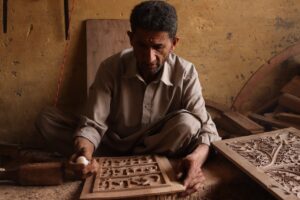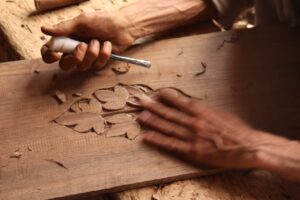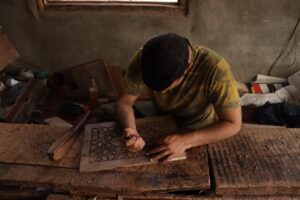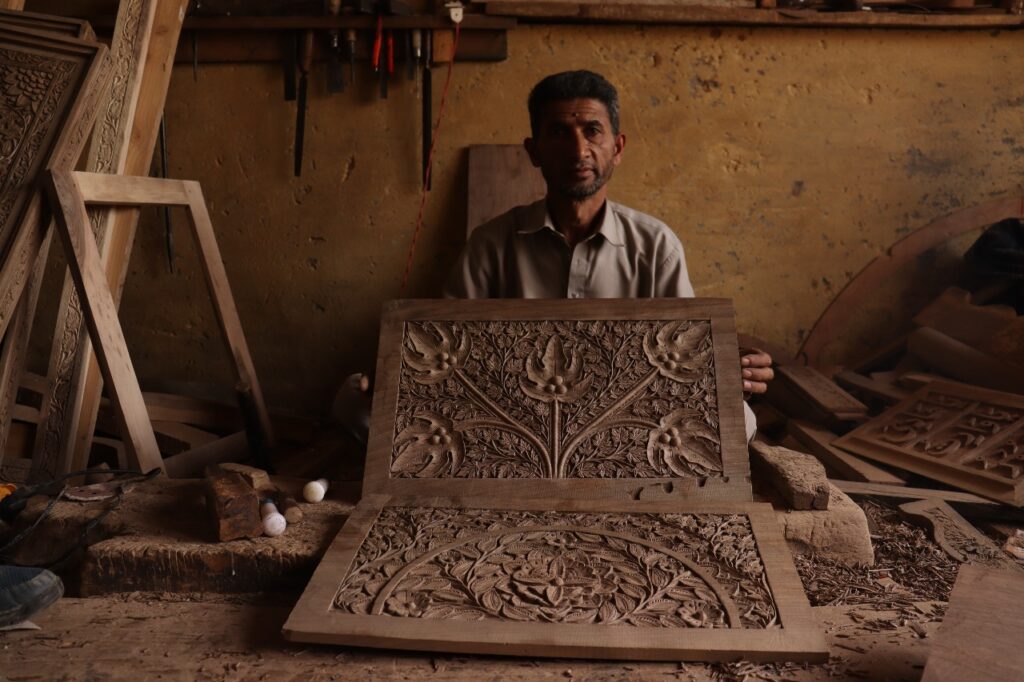Srinagar, Jammu and Kashmir: Amid rising challenges, Haft Yarbal area of Safa Kadal near here is carving out a niche artistic story on walnut wood. Just over three and a half kilometers away from Srinagar’s bustling Lal Chowk, a symphony of craftsmanship unfolds. Here, hundreds of passionate artisans, young and old, use their skillful hands to breathe life into wood.
Wood carving, known as ‘Doonhachi Kaem’ in the local Kashmiri language, is an ancient tradition that epitomises the art and heritage of Kashmir. Historical references trace the craft coming into the region from Central Asia some 600-700 years ago. Since its inception, walnut wood has been transformed into elegant furniture and exquisite home décor pieces, both in its natural form and as a canvas for intricate carvings.

Mohammad Ismail, 55, a milkman who embraced the art of wood carving to support his family, says he has been involved in this art for the last four decades. “I’ve dedicated my livelihood to a workshop nestled on the banks of the Jhelum River in Safa Kadal. Although, learning this craft is challenging,” he shares.
Ismail’s unwavering commitment to his artistry allows him to create any design his customers desire – be it sofas, tables, dining sets, or more.
While the market for wood carving has witnessed a decline since the 1990s, Ismail notes that local demand still prevails. “The younger generation shows less interest in this intricate occupation, deterred by its complexity. My children are no longer interested in art as they’ve switched to other trades,” he shares.
According to Ismail, the new generation feels that this is an art which requires more time to learn with fewer outcomes. Nonetheless, Ismail perseveres, adapting his designs to cater to changing trends and customer preferences.

Ismail’s journey to mastery took him four decades, a testament to the time and dedication required to acquire this skill. “Younger individuals have a better advantage in learning this craft, as they can adapt to evolving designs and trends more swiftly,” emphasises Ismail.
Only 10 per cent of the final product needs to go through the process of mechanisation, Ismail says. “The remaining 90% relies on the meticulous craftsmanship of experienced woodcarvers. Skilled artisans can earn between Rs 500 and Rs 700 per day, showcasing their expertise and dedication,” he says. While the export of wood carvings to international markets has dwindled over time, Ismail and his fellow artisans continue to find solace in their daily wages.
Another artisan, Waseem Ahmad Bhat, carries forward the legacy inherited from his forefathers. For the past nine years, he has honed his craft in his father’s workshop, joining the ranks of artisans preserving this exquisite art form.
The wood carving industry survived challenges including the clampdown of communication services in J&K during the abrogation of Article 370, which provided special status to the erstwhile state which has now become a Union Territory, and the COVID-19 lockdown.

Ghulam Hassan Mir, a seasoned woodcarver with over 50 years of experience says, “The number of orders received per month has dwindled to a mere five to six orders, which is a significant decline compared to two decades ago.”

Ghulam Hassan Mir calls for innovation and diversity in their creations. “Many artisans focus more on fancy looks rather than durability, which results in repetitive designs of chinar leaves, flowers, and jungle motifs,” he believes. “Furthermore,” he says, highlighting the issue, “counterfeit artisans deceive customers by using wood, rather than walnut, tarnishing the reputation of this traditional craft.”
To safeguard the cultural heritage of Kashmir and inspire the youth, Mir calls upon the government to take necessary steps, including providing training programmes for budding artisans.
Sheikh Aashiq, the president of the Kashmir Chamber of Commerce and Industry (KCC&I), acknowledges that wood carving is an integral part of the region’s heritage industry. Emphasising the need to retain and support the skilled artisans, he says, “Their craftsmanship contributes immensely to the art form. So, it’s important to promote wood carving through various platforms, both nationally and internationally.”
He suggests implementing skill courses at the district level to ensure the continuous growth and preservation of this trade.
In response to concerns about fake artisans using inferior wood, Sheikh Aashiq clarifies that the KCC&I acts as an advisory body. “We do not endorse or promote counterfeit practices,” he asserts. Stressing the need for strict punishments by the quality control council for those involved in selling fake products, Aashiq further says, “The geographic indication (GI) tagging is already in place to preserve the authenticity and quality of Kashmiri wood carvings.”

